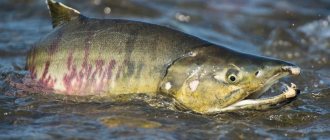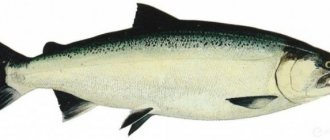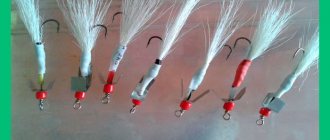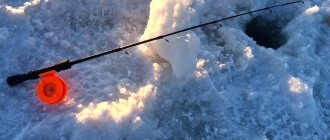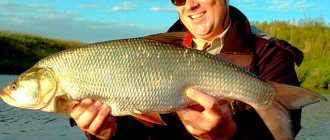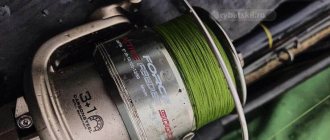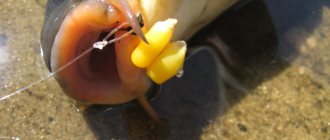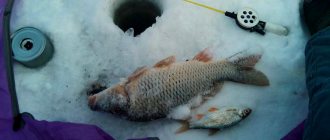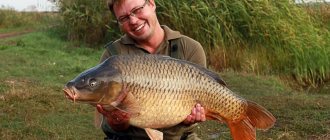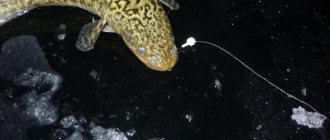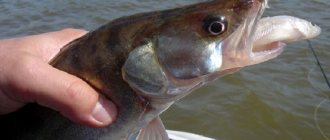Everyone loves red fish; it is considered the most delicious and dietary. But most people don't understand which one to call salmon. In fact, it is a collective concept that describes the common characteristics of several varieties. There is no such fish as salmon, but even scientists often call some species this way.
| Class | Ray-finned fish |
| Squad | Salmonidae |
| Family | Salmonidae, subfamily - salmonids |
| Genus | Lenki, Pacific salmon, noble salmon, char |
| View | Lenok, sockeye salmon, salmon, chum salmon, taimen, char, coho salmon, pink salmon, chinook salmon |
| Security status | Not endangered, but fishing is prohibited in some places |
| Size | Up to 1.5 m, up to 30 kg |
| Lifespan | 15 years |
| What does it eat? | Invertebrates, small fish, insects, caviar |
| Optimal feeding time | Spring and early summer, cloudy weather with a small wave, daylight |
| Enemies | Unknown |
| What do they bite on? | Spoons, wobblers, flies |
What is salmon called?
Red fish is very popular; not a single feast is complete without it. Many people call all its varieties salmon, but does such a fish really exist? In general, the word “salmon” is a collective concept, just like “trout”. There are no such fish in science, but this word is used to describe some species of salmon.
The word “salmon” is very ancient; in Indo-European it meant “to be speckled.” But these fish were not called that right away. The first classifications of ray-finned fish included them in the herring family.
Now there is a separate salmon family, which is divided into 3 subfamilies: whitefish, grayling and salmon itself. It is representatives of this subfamily that are often called salmon.
A species of fish of the salmon subfamily
There are many classifications of salmon, and sometimes even scientists get confused. Most often, all these fish are divided into three groups:
- Pacific salmon - chum salmon, pink salmon, chinook salmon, sockeye salmon, coho salmon;
- noble salmon - salmon, trout;
- loaches.
The most common are the first two, which have this word in their names. This is what they often call any variety, without understanding what the difference is between them. This word is often used instead of the name salmon. Therefore, the question of how salmon and salmon differ is incorrect.
All species of salmon have some peculiarities of appearance and behavior. But only a specialist can understand whether they are different from each other. For ordinary people, this is all salmon.
- Salmon is the largest fish of this family. It grows more than a meter long, up to 45 kg. What else is the difference between salmon and salmon: its body is silvery, there are very few dark spots.
- Pink salmon are easily identified by their characteristic pattern of many spots. It is small, growing no more than 70 cm. It is especially easy to see the difference between pink salmon and salmon during spawning. At this time, the male becomes hunchbacked and his teeth grow.
- Chum salmon has the most tender dietary meat. She has medium size, small eyes, an elongated body with light gray scales.
- It is easy to understand how sockeye salmon differs from other salmon. She has meat and almost the entire body is bright red.
- Coho salmon is a small fish with a beautiful silver color. But during spawning it can also turn red.
- Chinook salmon is the largest of the salmon subfamily. She grows up to 50 kg. Chinook salmon meat is very tasty and has valuable nutritional qualities. A distinctive feature is clearly defined gill stripes.
Trout is classified as a separate species, but this is also a collective concept. There are several varieties depending on their habitat and color. There are Adriatic trout, lake trout, rainbow trout, Arizona trout, golden trout, Sevan trout and others.
This is also a valuable commercial fish, so many are interested in the question of how trout differs from salmon. First of all, it is smaller, never growing more than 4 kg. In addition, she has a beautiful coloring with spots, sometimes multi-colored, and there is a pink stripe along the body.
Atlas of salmon of the Sakhalin region
The atlas presents 13 species of salmon that live or are found in the waters of the Sakhalin region. These are 11 species of the Salmon Family and 1 species each from the Grayling and Whitefish families.
- Chum salmon
- Pink salmon
- Sockeye salmon, red
- Coho salmon
- Sima
- Chinook
- Kunja
- Malma
- Sakhalin taimen
- Siberian taimen
- Lenok
- Amur grayling
- Amur (Ussuri) whitefish
Chum salmon
Chum salmon mature for spawning and enter rivers at the age of 3-6 years (mostly at 4 years) with a body length of up to 90 cm and a weight of 2-11 kg. The fertility of chum salmon averages 3000 eggs. Caviar with a diameter of about 7 mm. The spawning run begins in August, and mass entry and spawning begin in the second half of September - October. Spawning grounds are located in the lower reaches or middle reaches of the river, in areas with pebble and gravel bottoms. The larvae hatch in the spring, and they immediately roll into the sea. In the first summer, juveniles live in coastal waters and later migrate to open waters. During the marine period, it feeds on invertebrates and young fish. After 2-4 years, the fish begins to migrate to their native rivers.Pink salmon The size of pink salmon varies greatly. The average weight is 1.3-1.4 kg, length 29-68 cm, with the smallest and largest individuals being males. The sizes of females are more stable, their average length is 47-49 cm. Pink salmon is a fast-growing species, maturing in the 2nd year of life. In the sea, pink salmon feed on large planktonic crustaceans, squid, and anchovies. The movement into the rivers begins in June and continues until the end of August, spawning takes place in August-September. Spawning grounds are located along the main riverbed and along the lower reaches of large tributaries on rifts with clean water and on silt-free soil of gravel and pebbles mixed with sand. Fertility averages 1500 eggs. Caviar with a diameter of about 6 mm. The embryos hatch from the eggs 90-120 days after fertilization (in December) and remain in the nests until spring, feeding on the reserves of the yolk sac. At the end of April, the larvae begin to slide down the river. After going to sea, the juveniles stay near the coast for about a month, actively feeding on small crustaceans, then go into the open waters of the sea for a year and a half.
Sockeye salmon, red Sockeye salmon begins spawning migration in the second half of June, and in August enters rivers and lakes. Moreover, the fish has a mass of about 2 kg and a length of 46-66 cm. In the river, the fish changes beyond recognition. Sockeye salmon spawn in September - October on lake and river spawning grounds and in places where spring waters emerge. After 55-170 days (the period depends on the water temperature), embryos emerge from the eggs. They are in the ground until May-June. The fish go to sea at the age of 1-3 years. Some of the juveniles remain, forming a dwarf form. The juveniles that have rolled into the sea live for 2-3 years, feeding on the larvae of flounder and other species of fish and crustaceans. In the open ocean, food includes squid and fish. Sockeye salmon lives within the Sakhalin region only on the Kuril Islands.
Coho salmon Coho salmon reaches a length of 98 cm and a weight of 14 kg. The usual length of fish that go to spawn in rivers is 40-80 cm and weight is 3.0-3.5 kg. Spawning is extended and lasts from September to March. Spawns in areas with groundwater outlets and weak currents. Average fertility is 4500-5500 eggs. The diameter of the eggs is about 4.5 mm. The incubation period, depending on the water temperature, is 50-160 days. The juveniles live in the river for 2-3 years, feeding on aerial insects, their larvae, and the eggs of other salmonids. The migration into the sea continues from June to August. Coho salmon do not go far into the sea, living mainly in coastal waters. The marine life period is short; after 1-2 years it returns to the rivers for spawning. This species is not numerous in the waters of Sakhalin and is found mainly in the rivers of northeastern Sakhalin and Terpeniya Bay.
Sima
Typically, the length of the sima is 50-60 cm, and the weight is 2.5-3.5 kg. It lives in rivers for 1-3 years and can form residential freshwater forms. The marine life period lasts 1-2 years. In the sea, the masu feeds on crustaceans, and less often on juvenile fish. Enters rivers at the age of 3-5 years. The spawning run begins in mid-May and continues until July. Spawning grounds are located in the upper reaches of rivers and key channels. Fertility - up to 3000 eggs. The incubation period lasts 45-70 days. The migratory mama dies after spawning, and dwarf males participate in spawning the following year. After leaving the nest, fry of the masu salmon do not roll into the sea; juveniles, 5-6 cm long, move to reaches and riffles, where they feed on larvae, water and aerial insects. Juveniles living in rivers are known as pied, wheatear, and sculpin. The masu fish migrates to the sea at 2-3 years of age with a body length of 6-18 cm. The masu fish returns to its native rivers after 1-2 years. Sima is typical only for rivers of the Asian Pacific coast.
Chinook
Chinook salmon are the largest Pacific salmon. Reaches a length of 78-103 cm and a weight of 5-36 kg. It is not found in the rivers of Sakhalin and the Kuril Islands. However, there have been cases of catching this fish with fixed seines, especially in the Kuril Islands. It is possible that Chinook salmon also enter rivers in single specimens from May to August. Lives in the sea for 4-7 years, feeds on crustaceans, fish and squid. Its main habitat in the Far East is Kamchatka.
Kunja
Kunja is a large fish, reaching a length of 99 cm and a weight of 11 kg (usually 30-75 cm long and weighing 0.3-5.7 kg at the age of 2-4 years). Lives up to 9 years. Reaches sexual maturity at 3-4 years of age. To spawn, it enters rivers in June - August. Spawns in September. The spawning pattern is similar to that of Pacific salmon. The female lays from several hundred to 2270 eggs. Anadromous and dwarf males take part in spawning. Spawned individuals remain in the river until spring, and then slide into the sea. During the feeding period at sea, it stays in the pre-estuary areas of rivers or near the coast. In summer it feeds on smallmouth smelt, sand lance, gobies, and juvenile Pacific salmon as they migrate into the sea. For the winter, the brown trout returns to the rivers. The young spend 2-4 years in the river, after which they begin to migrate to the sea to feed in the summer months. In the river, juveniles feed on caddisfly larvae and other insects.
Dolly Varden, southern anadromous Dolly Varden, Pacific char
The size of Dolly Varden varies greatly by region, reaching a length of 91 cm (usually 40-55 cm) and a weight of 18.3 kg. Reaches sexual maturity at 5-6 years of age. In the sea, Dolly Varden feeds on large zooplankton and fish. In the spring it approaches the banks and enters rivers to spawn from July to August. It spawns on rocky areas of river bottoms covered with fine gravel and lays eggs in nests. The diameter of the eggs is 3.8-4.0 mm. Spawned individuals, after staying in the river, slide into the sea in September. Most often, they do not stay in rivers for the winter. They live near the coast, near river mouths, posing a threat to young Pacific salmon during their migration to the sea. Juveniles and immature fish live in the river for 2-4 years, feeding on mollusks, larvae of aquatic invertebrates, and fish eggs. In rivers they live mainly in fast mountain tributaries, fairly shaded by forest.
Sakhalin taimen, Far Eastern lentil, goy
Sakhalin taimen is a large fish, maximum length is 100 cm, weight 25-30 kg (usually less than 75 cm long and weighing up to 5 kg), maximum age is 9 years. In the sea it lives near the coast, near river mouths. To spawn, it migrates to fresh waters. Spawning in May-June, on rifts, in the lower reaches of fast-flowing rivers. Spawned fish do not die. The caviar is orange in color, with a diameter of 5.2-5.3 mm. Fecundity ranges from 6 to 76 thousand eggs. It lays eggs in nests. The incubation period lasts about two months. Juveniles spend the first years of their lives in rivers, feeding on insect larvae. A typical predator whose food is dominated by fish (smelt, minnows, etc.) and juvenile salmon eggs.
Siberian (common) taimen
Siberian taimen is a large fish, reaching a length of 150 cm and a weight of 60-80 kg. Taimen prefers fast mountain and taiga rivers and clean cold-water lakes. It becomes sexually mature at 4-6 years of age. It spawns in May in small channels, on pebble soil. Fertility is 10-34 thousand eggs. Lays eggs in nests. During spawning, the body turns copper-red. After spawning, as well as in autumn and winter, it feeds intensively. A typical predator whose food is dominated by small fish. In summer it stays in small channels; by autumn it descends into the beds of large rivers and lakes. Never goes to sea.
Lenok
Lenok reaches a length of 70 cm and a weight of 8 kg (usual length 45-50 cm, weight 2-3 kg). A slow-growing fish, it lives in the foothills of rivers, without making long migrations. Spawns in May-June. Fertility is 4-8 thousand eggs. Caviar with a diameter of 2.5-3.0 mm. Adult fish partially die after spawning. It feeds on small fish and can eat frogs and mice. It also eats benthic invertebrates - the larvae of stoneflies, caddisflies and mayflies. In summer it stays in small channels; by autumn it enters river beds.
Amur grayling
Grayling reaches a length of 60 cm. It lives in rivers and mountain tributaries, including small rivers. Ripens at 3-5 years of age. Spawning in the spring, at the end of May - beginning of June, takes place in small fast rivers. Fertility is 5-10 thousand eggs. It feeds on aquatic insects, their larvae, fish, and eats salmon eggs washed from their nests.
Amur (Ussuri) whitefish
The Amur whitefish reaches a length of 60 cm. It lives for 10 years. Usually lives in freshwater lakes and rivers. Rarely found in salt water. Ripens at 5-6 years of age. Spawning in autumn. Adult fish feed on small fish and large larvae of aquatic insects. One-year and two-year-old Ussuri whitefish feed in shallow coastal waters, while adults choose open, deep places.
Appearance
Red salmon fish has characteristic features. She has a narrow, elongated body, laterally compressed and covered with silvery scales. A distinctive feature of salmon is the presence of an adipose fin. It is located on the back near the tail and has no rays or spots. You can also note the following external signs:
- dorsal and pelvic fins are multi-rayed, but without spines;
- the body is covered with dark specks or spots;
- in the middle along the body there is a darker line;
- the head is not made of bone, but of cartilage tissue;
- there are transparent eyelids;
- the belly is light and the back is almost dark;
- powerful jaws with sharp teeth.
A characteristic feature of salmon, as well as salmon, trout, chum salmon, sockeye salmon and other species is the ability to adapt to living conditions. The appearance of males changes especially often before spawning. They acquire a bright red color and change body shape.
Salmon fish can be of different sizes: from several tens of cm to 2 m. The largest individuals can weigh up to 70 kg. But usually salmon and salmon do not grow more than 1 m and reach a size of up to 45 kg.
Features of lifestyle and nutrition
Trout, salmon, salmon, chum salmon and pink salmon live in the northern part of the Pacific and Atlantic oceans. There are many of them in the northern seas. Salmon are found in the rivers and lakes of Siberia, Yakutia, the Far East, Kamchatka, and some species live in Baikal. Trout or salmon can be found in Karelia, Lake Onega, and northern European countries. They are even bred in Norway.
Trout, salmon, salmon, chum salmon, and coho salmon prefer clean, oxygenated water. They can live in both sea and fresh water, but to reproduce they always go up the river. Therefore, they are classified as migratory fish. They spawn in autumn and winter until January. The favorable water temperature is 3-80.
This is the main feature of salmon behavior. Sockeye salmon, chinook salmon, salmon, coho salmon and pink salmon hatch from eggs in the river, grow and feed there. After a few years they go downstream into the sea. There they live until they reach sexual maturity. When it's time to spawn, they move upstream to the place where they were born. These representatives of salmonids die immediately after spawning.
Red salmon and salmon also go to spawn in fresh running water. But they can spawn 3-5 times without dying after laying eggs. Interestingly, the females prepare a place for laying eggs. They make depressions at the bottom, and cover the swept eggs with sand or pebbles.
Attention!
A peculiarity of all salmon fish is that before spawning they stop feeding. Their meat becomes tough, tasteless, and turns pale.
Usually all salmon are quite voracious. These are predators; they feed on small fish, mollusks, and crustaceans. The most popular species are herring, vendace, smelt and sand lance. Young salmon prefer zooplankton and crustaceans. The larvae of insects that have fallen into the water can also eat.
Pacific salmon
Sockeye salmon, together with five species - masu salmon, pink salmon, coho salmon, chum salmon and chinook salmon, belongs to the genus Oncorhynchys. The range of representatives of this genus is limited to the northern part of the Pacific Ocean. The southern border of the range is on the island of Taiwan in Asia and in California in America. Some Pacific salmon, such as chum salmon, enter the rivers of the Chukchi Sea to breed. Only masu salmon enters the rivers of the Asian coast, while all other species breed in freshwater bodies of both continents. Feeding areas in the sea to some extent gravitate towards the continents, which own the spawning reservoirs of local stocks. Most of the local herds of all species winter and fatten within the subarctic region of the northern Pacific.
Mature males and females of the same age in different species have noticeable differences in body size and weight. Studies of structural features have revealed the existence of a series: masu salmon - sockeye salmon - pink salmon - coho salmon - chum salmon - chinook salmon, in which there is a tendency to increase the mass of cartilage and shelter the brain from the influence of the external environment. The differences between species are most obvious when salmon have their nuptial plumage, since at this time a special body shape and coloration are acquired.
Pacific salmon breed in rivers and lakes, using sandy and pebble soils with a well-defined groundwater outlet or under-channel flow. Sima breeds in small tributaries and upper reaches of rivers. Chum salmon and pink salmon in such rivers occupy areas downstream for spawning. Pink salmon quite often breed in the intertidal zone of the mouths of small rivers with well-defined sandy and pebbly soil. Chum salmon often migrate to the middle sections of large rivers. Sockeye salmon breeds in lakes and rivers flowing into lakes, on the one hand, and in the upper reaches of large rivers, on the other. Coho salmon spawn in rivers, their tributaries, springs, very often in shallow areas with low water flow rates.
Read: How to catch pink salmon?
At the same time, Chinook salmon mainly choose relatively deep-water sections of rivers with fast currents. Chinook salmon use specific areas of rivers for spawning grounds - before the riffles with sufficient depth and fast current. In the upper reaches of the Kamchatka River, Chinook salmon breed in shallower areas with slower flows.
To visualize the selectivity of Pacific salmon in terms of breeding sites, let us turn to spawning reservoirs where several species occur simultaneously. Thus, in the basin of the Dalnyaya River (Kamchatka), all sockeye salmon breed in Dalny Lake, while coho salmon occupy areas adjacent to the source of this river from the lake. In the Wood River Basin (Alaska), we observed a mass spawning of pink salmon in the main channel of the Wood River connecting Lake Aleknagik to the sea in late August and early September. Sockeye salmon spawn in rivers flowing into lakes Aleknagik and Nerka. occurred at the end of July, while on lake spawning grounds - in the second half of August. The spawning grounds of Chinook salmon were located on a mountain-type river - the Agulovak River, connecting these two lakes. Chum salmon bred in places in the lower reaches of the rivers flowing into these lakes, the upper reaches of which were occupied by sockeye salmon.
Marriott notes an occasional occurrence of chum salmon for the Peak River (Nerka Lake). We were able to observe 9 pairs of female chum salmon and male sockeye salmon breeding together. At the same time, students at the University of Washington discovered a mature hybrid of sockeye salmon and chum salmon. Thus, in cases where the breeding grounds of different species of Pacific salmon are located in the vicinity and the spawning time coincides, natural hybridization cannot be excluded, which we noted for sockeye salmon and chum salmon in Lake Nerka, Lake Azabachye, as well as in other places by many authors.
Read: Chinook salmon fishing in Kamchatka
The number of each species of Pacific salmon depends on the conditions for reproduction. The abundance of lakes has led to high numbers of sockeye salmon in the Wood, Kvichek, Naknek and Ugashikk river basins in Alaska; Skeena and Fraser in Canada, Kamchatka and Ozernaya on the Kamchatka Peninsula. The short, shallow rivers of Sakhalin Island and the Kuril Islands are characterized by an abundance of pink salmon and chum salmon. The abundance of mountain rivers in the states of Washington and Oregon, as well as in British Columbia, ensured high numbers of coho and chinook salmon. In Asia, the most abundant species are chum salmon and pink salmon, and in North America - sockeye salmon, chinook salmon and coho salmon. Sima is a small species.
Pacific salmon are monocyclic and die soon after the end of spawning; the lifespan of different salmon species can vary significantly. These differences are enhanced by the unequal duration of the freshwater life period. Hence, there are species with a complex age structure and a sharply simplified one.
If 21 age groups are known for sockeye salmon, and 14 for chinook salmon, then pink salmon is represented by almost one age group, since its freshwater and marine periods of life are simultaneously maximally reduced. Chum salmon are distinguished by the fact that they spend a long time at sea and are therefore represented by six age groups. The third pair of species, salmon and coho salmon, have taken the path of reducing the duration of their stay in the sea, while the freshwater period of life sometimes remains very long. Despite the fact that 10 age groups have been found in coho salmon, only two of them are dominant, and the majority of coho salmon live in the sea for one year. Sims have a slightly larger proportion of age groups that spend two years at sea.
Read: Fishing in Alaska
Pacific salmon make long migrations both in fresh waters and in the sea. In connection with the development of active Japanese salmon fishing on the high seas, in the last twenty years, research into the marine period of life has expanded widely, including determining whether fish in the ocean belong to certain local stocks. As a result, it was possible to identify such important feeding areas as the Bering and Okhotsk Seas, the Aleutian region and the Gulf of Alaska in the North Pacific Ocean. Salmon winter in the Sea of Japan, the Kuril region of the Aleutian Pacific Ocean in the southern Gulf of Alaska, and the Oregon-Vancouver region.
The longest migrations are obviously carried out by the Amur autumn chum salmon. Using tagging, it was established that she, as well as chum salmon from the Hokkaido and Sakhalin islands, feed in the Aleutian region of the Pacific Ocean (Adak Island) and migrate from there to spawn. The marine life period of sockeye salmon, chum salmon and pink salmon is the most well studied. There is comparatively less information about the marine period of chinook and coho salmon, and there is only sporadic data on the distribution of salmon
Larvae, fry and juveniles of Pacific salmon feed on bottom and planktonic organisms, as well as aerial insects. Typically, fish from river stocks, such as chum salmon, sockeye salmon, and coho salmon, feed on drifted benthos and aerial insects. In lakes, planktonic organisms occupy a significant proportion of the diet. Large juveniles at the age of 2 and 3 years switch to feeding on amphipods, on the one hand, and juveniles and small fish, on the other. In the ocean, the main diet of salmon consists of large planktonic crustaceans, such as euphasiaids and hypereids, as well as fry and juvenile fish, small squids, etc.
Pink salmon Chum salmon Coho salmon Sockeye Sima Chinook salmon
Salmon fishing
Salmon or trout are the most popular species for salmon fishing. But fishing is also common for other members of the family. Since they are strong and cunning predators, catching them is considered an extreme sport. This fish can jump high and swims very quickly.
It is very important for a fisherman to choose the right gear. Such a fish will not take a rough one, and besides, it has a weak mouth, so you need to use a fishing line. But it must be durable. It is recommended to fish with a spinning rod with a reserve of fishing line in the reel of at least 150 m. Rotating or oscillating spoons and wobblers are used as bait.
The best time to catch salmon on the sea or lake is in early spring and early summer. Around mid-June it has already been moving into the river. At this time, fishing is not so popular, since while salmon are in the sea, their meat is tastier. They feed more actively in cloudy weather, especially if there is a slight wave.
Far Eastern gold: how Russia is losing salmon
At the beginning of June, the so-called red poutine started in the Far East. Fishing vessels from various ports in the region set out for the most valuable resource of the Pacific Ocean - salmon. About the expectations and fears of the “big fishing” season - in the material of the FederalPress correspondent.
The fish are getting smaller
Experts call last year's Putin a failure. Fishermen managed to catch 300 thousand tons of salmon - this figure, by industry standards, is quite insignificant. In previous times, catches were much more serious: in 2018, for example, twice as many fish were caught in the net.
Rosrybolovstvo promised to carefully analyze the situation, especially regarding forecasts for salmon production. This year, the department announced that they have allocated serious money for complex scientific research.
“I hope that these measures will allow us to increase the accuracy of forecasts starting this year, so that fishermen can calculate their production forces in advance,” said Ilya Shestakov, head of Rosrybolovstvo.
The fact remains: there is less fish in the Far East, and everywhere. Experts say: it won’t increase this season either. Moreover, this is not a purely Russian, but a global problem. There are no salmon in the same quantities either in Kamchatka or in Alaska. Scientists blame this on fishing pressure on fish and global warming.
Pessimistic forecasts are already beginning to come true. Salmon catches in Alaska in 2021 were the lowest in three years. And since the Russian fish in the winter of 2020-2021 went to “grow up” in waters shared with Alaskan herds, we can expect the same picture here.
Now we are talking about a banal natural cycle, believes the president of the Association of Fisheries Enterprises of Primorye Georgy Martynov . According to him, the salmon population periodically decreases and increases.
“25 years ago, production of 250, even 220 thousand tons was very good, simply magnificent. Of course, compared to 2018, when the catch was approximately 620 thousand tons, 2021 turned out to be worse. But he's not a failure. This is nature, it is cyclical,” Martynov is sure.
He added that all decisions must be coordinated with science, which can accurately calculate the volume of aquatic biological resources for the coming year. But they don’t always listen to scientists—it’s often more important for officials to achieve high results. The consequences of this are sad.
Will the Far East be left without salmon?
This year, in the Khabarovsk Territory, fishing was allowed only in the sea. But summer poutine was banned in the spawning Amur. The autumn season starts on August 20, and officials have distributed quotas of 13 thousand tons - this is almost twice as much as was caught last year.
“The approaches of chum salmon to the Amur are decreasing. The volume of permissible fishing in recent years has been disproportionately large compared to stocks. Because of this, fishermen at the mouth of the Amur run the risk of catching that part of the fish that needs to be sent to spawning grounds,” explains Olga Cheblukova, .
The World Wildlife Fund, together with volunteers, has been monitoring the filling of the largest spawning tributaries of the Amur - Amguni, Anyuya, Tunguska, Gura and Gorina - for three years now. Olga Cheblukova gives depressing figures for autumn chum salmon: with a norm of 50 specimens per 100 square meters in 2021, there were 0.1 fish per such area. In 2021, there was an average of less than one fish per square meter. In 2021 the situation was better, but not by much.
“Our results for summer chum and pink salmon are also deplorable. In the eighteenth year, we found only single individuals in the Anguni and small rivers of the Nikolaev region. In 2019, less than one specimen of chum salmon was recorded per hundred square meters. At the same time, the norm is the same – 50 individuals,” she adds.
Chum salmon went poorly for spawning back in 2021 – then Khabarovsk fishermen complained about “harvest failure” on social networks and the media. Now the “descendants” of that fish are returning to the waters of the Amur: the “journey” from the rivers to the ocean and back takes four years. This means that 2021 will not be rich in catches, much less than the figure that Rosrybolovstvo optimistically recommends for production.
“Unfortunately, even the restrictions on fishing, which began to be introduced in 2021, do not significantly change the situation with salmon. Thus, in the Khabarovsk Territory in 2021, out of 15.6 thousand tons of autumn chum salmon recommended for catching, only half was caught. At the same time, the spawning grounds were very poorly filled. It turns out that the measures taken were insufficient,” says an employee of the Amur branch of WWF.
Olga Cheblukova is sure that if the trend continues, not only summer fishing will have to be banned, but also autumn fishing. In this case, it will be bad for everyone - fishermen, ordinary people, and regional authorities. In addition, nature will begin to suffer - salmon, after all, are an important part of the ecosystem. So in the near future, Rosrybolovstvo will have to make a choice - to further increase the pace, exacerbating the problems, or to take a break.
Photo: kamgov.ru, FederalPress / Elena Mayorova
The nutritional value
Red fish is the most valuable source of Omega 3 unsaturated fatty acids. They slow down the aging process and improve memory. In addition, it contains many antioxidants, vitamins A, D, PP, B, phosphorus, chromium, and potassium.
Salmon are sold chilled, frozen, smoked or salted. A lot of different canned goods and preserves are also produced. Moreover, the variety is not always indicated. Therefore, it is difficult for many to determine which is better, salmon or pink salmon. It’s just that pink salmon is the most common red fish, so it’s more common.
But what tastes better, salmon or salmon, can be determined unambiguously. It’s not for nothing that salmon is called the “queen of salmon.” It has fatty tender meat without a specific smell. In addition, it contains a lot of easily digestible protein and amino acids. Although many experts consider the question of which tastes better, salmon or salmon, to be incorrect. After all, salmon is often called salmon.
But you can figure out which fish is the fattest of all salmon. Chinook salmon, sockeye salmon and coho salmon contain the most fatty acids – from 6 to 11%. They have tender pink meat, quite high in calories and tasty. Chinook salmon is even called the “prince of salmon”, as it is tastier than other salmon.
But these varieties are rare, so consumers are often concerned with the question of which fish is fattier: salmon or trout. Here we can definitely answer that it is salmon. This is generally the fattest red fish - it contains 15% fat. Trout meat is a little dry, it contains only 4-5% fat, but it is more dietary and low-calorie.
Salmon is the name given to many fish of the salmon family. Usually this word is used in relation to salmon. But chinook salmon, coho salmon, sockeye salmon, chum salmon and pink salmon are also salmon.
Popular salmon fish and their description
It will be interesting and instructive for domestic fishermen to learn about those representatives of the salmon family that can be caught by an amateur fishing rod. Among them there are both trophy fish and small inhabitants of fast rivers.
Representatives of Siberian rivers
The three most popular representatives of the salmon family are found in Siberia. This is a large taimen, as well as its small relatives lenok and grayling.
Taimen is found in rivers and large lakes of Siberia, Altai and the Far East. This Siberian salmon can reach a length of over 1 m, and the weight of the giant reaches 60 kg. This fish is rightfully classified as a long-livers, since the age of individual individuals is 50 years.
It should be noted that the most catchy areas for fishing enthusiasts are the basins of the Amur, Lena, Yenisei and Lake Baikal rivers. In those regions where people mined gold, this fish, unfortunately, disappeared. A lot of taimen are still found in the hard-to-reach rivers of Yakutia and Evenkia. The main object of hunting for this predator is pike.
Currently, several varieties of taimen can be mentioned.
- The largest and most interesting for fishermen is the Siberian taimen. This is a typical freshwater fish with a large population and can grow up to 60 kg.
- Korean taimen has been poorly studied, and information about it is controversial.
- Until recently, Danube salmon was on the verge of extinction. However, recent research gives ichthyologists optimism.
- Sakhalin taimen, despite the common name, is not related to taimen. This is a migratory fish species, while all taimen are freshwater inhabitants.
Lenok is widespread in Siberian rivers. In this species of fish, a distinction is made between blunt-snouted and sharp-snouted modifications. Lenka is abundant in the Far Eastern, Mongolian, Chinese and West Korean rivers.
Lenok lives in the upper reaches of cold and fast rivers. Small individuals up to 40 cm long and weighing up to 1 kg live in flocks. And large individuals up to 90 cm long and weighing up to 6.5 kg prefer to live alone.
There is some disagreement among ichthyologists regarding the species diversity of lenoks. There are basically two camps. One of them contains blunt-snouted representatives, and its competition comes from sharp-snouted relatives. While the former tend to feed on insect larvae, the latter specialize in rodents. The largest weight of lenok caught was 8 kg.
This representative of salmon is distributed in all reservoirs of Siberia. Large populations are found in the tributaries of the Amur, Ob, Yenisei, Lena and Lake Baikal. All graylings differ in their coloring. Scientists distinguish 4 varieties:
- West Siberian;
- East Siberian;
- Kamchatka;
- American (Alaskan).
Grayling is one of the smallest representatives of salmon. Having reached the age of 10 years, the fish is able to gain weight of about 2 kg and grow up to 50 cm.
Photo 3. Baikal grayling.
Atlantic salmon
In addition to salmon, the group of Atlantic or noble salmon includes brown trout and trout.
- Salmon is considered one of the most delicious fish. This representative of salmon can reach 1.5 m in length and 45 kg in weight. The habitat of salmon is not limited to the Atlantic Ocean; the fish also thrives in the cold waters of the Arctic Ocean.
- Brown trout are also lovers of cold water, but this fish is more attached to freshwater areas. Even when at sea, she tries to stick to the coastal zone.
- Trout even resembles brown trout in appearance, which confirms their close relationship.
- In the south of the Atlantic, a Caspian population can be distinguished, some representatives of which gain weight of 50 kg.
The noble salmon that live in northern waters are very popular among fishing enthusiasts. Even in the Neva there are specimens weighing 40 kg.
Pacific salmon
Pacific or Far Eastern salmon comprise 6 species of fish that breed in freshwater bodies. In them, adult individuals die after spawning. Residents of the Far East especially value chum salmon and pink salmon.
- Pink salmon is the most abundant Far Eastern salmon. The distinctive features of this fish are the presence of round black spots on the caudal fin. If we compare pink salmon with other Pacific relatives, they have a thicker caudal peduncle. The fish cannot boast of its size; the length rarely reaches 75-80 cm, while the weight is limited to 5.5-6 kg. Before spawning, pink salmon changes color, it develops a hump, and the shape of its jaws changes.
- The second largest species of Far Eastern salmon is chum salmon. The size of an adult individual can reach 1 m with a weight of about 15 kg. Unlike other relatives, when entering fresh waters before spawning, the fish does not change in appearance.
- Pacific salmon also includes such well-known fish species as coho salmon, nelma and chinook salmon.
